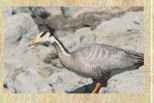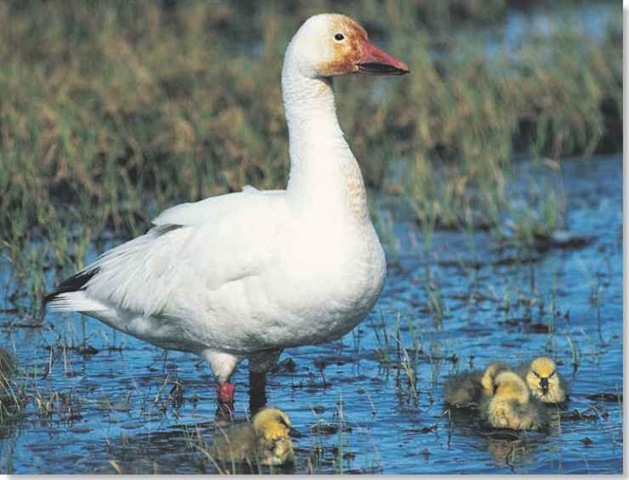ORDER
Anseriformes
FAMILY
Anatidae
GENUS & SPECIES
KEY FEATURES
• Exists in two color forms, white and blue,-and two races:-the greater and the lesser snow goose
• One of the world’s most abundant species of goose, with populations numbering in millions
• Annual migrations to wintering grounds are among the greatest of all wildlife spectacles
WHERE IN THE WORLD!
Breeds mostly inside thetfin Island and Greenland west across-Canada; migrates in winter to warmer parts of the-U.S.
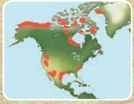
Lifecycle
Vast flocks of snow geese breed on the Arctic tundra, exploiting the brief flush of plant growth. Each autumn they head south to spend the winter in the southern U.S.
Habitat
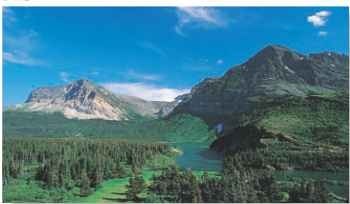
A Peaceful pastures snow geese favor areas of vegetated wilderness that provide ample food and-shelter.
The snow goose breeds in the Arctic, usually on lowland grassy tundra and often close to lakes, pools or flooded plains. Some birds, including the greater race, which breeds in Greenland, nests on mountain slopes and ledges.
In its southern U.S. wintering quarters, the snow goose prefers farmland, grassland and wetlands (right), close to coasts. The tall, dense grasses and sedges provide cover and food, allowing the goose to build up its reserves of body fat before its arduous return to the north.
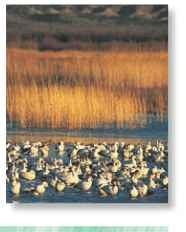
conservation
Both races of snow goose have increased considerably since the 1950s, due not only to restrictions on hunting but also to the-new feeding opportunities provided by fields of crops, some planted specially for the migrant geese.
Breeding
The snow goose does not start to nest until June, when tundra topsoil thaws. Food is still scarce after the deep Arctic freeze, and so a breeding pair relies on protein and fat reserves built up while overwintering. It must produce several eggs and incubate them for a month, and if the two birds lack sufficient energy reserves, they may abandon the clutch or even die of starvation.
A newly hatched gosling faces the hazards of predation and bad weather. Furthermore, it must set off on its first southbound migration just a few weeks after it has learned to fly. Within the flocks, the young stays with its parents and siblings. This gives it the best chance of reaching its winter quarters safely
a goose’s year
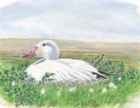
Sits…
A female incubates eggs in a shallow depression on the ground, lined with moss, grass and feathers from her breast.
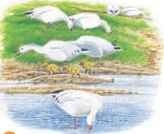
Instructs…
Goslings learn where to find the best food by following their parents. The flock builds up body fat before migrating south for winter.
Behavior
Most wildfowl are gregarious, but the snow goose is particularly so. It spends the year in huge flocks, sometimes numbering tens of thousands, even when migrating. This social lifestyle has a number of advantages: it provides safety, helping the bird avoid being taken by predators, and it helps juveniles locate the best feeding sites and learn the correct migration routes. As they fly, the snow geese — among the noisiest of all wildfowl — maintain contact by uttering a continual chorus of barking and yelping calls.
Each autumn, the greater snow goose migrates south to winter on the Atlantic coast of the United States, from Maryland to North Carolina. The lesser snow goose heads for California, northern Mexico and southern states on the Gulf Coast. Some birds fly without stopping for 2,100 miles or more to the Gulf of Mexico, completing the journey in less than 60 hours. They fly at an average speed of 35 mph.
Packed lunch snow geese descend on crop fields to feed during long migrations.
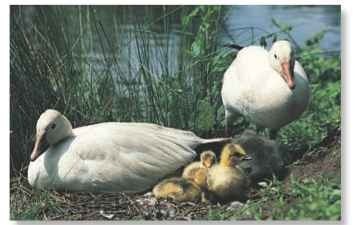
Food & feeding
Almost entirely vegetarian, the snow goose obtains most of its food on marshy ground, rough grassland and arable farmland, by digging it out of the soil and mud or by grazing. During the brief Arctic summer, a breeding bird digs out the bulbous roots and succulent underground stems of aquatic plants.
In its winter quarters, the goose excavates and eats aquatic plants on brackish and saltwater coastal marshes. When large flocks feed in this way they soon transform lush areas of marshland into a-muddy waste, pockmarked with holes made by their probing bills. Such-areas may take several years to recover completely, so the birds must find new feeding grounds the following year Increasing numbers of snow geese devour crops such as cereals and waste grain, which has led to conflict with farmers.

Probing bill The snow goose may feed while on the water, foraging for juicy plants in the shallows.

Snow geese are often kept in captivity in areas such as Britain. One population of over 60 birds inhabits the islands of Mull and Coll, off western Scotland.
Many snow geese have a brown-stained head caused by the specks of ; iron oxide they pick up in the Arctic soil.
Profile
Snow Goose
With its robust body, muscular neck and sharply serrated bill, the snow goose is well adapted to digging up a variety of plants and vegetables.
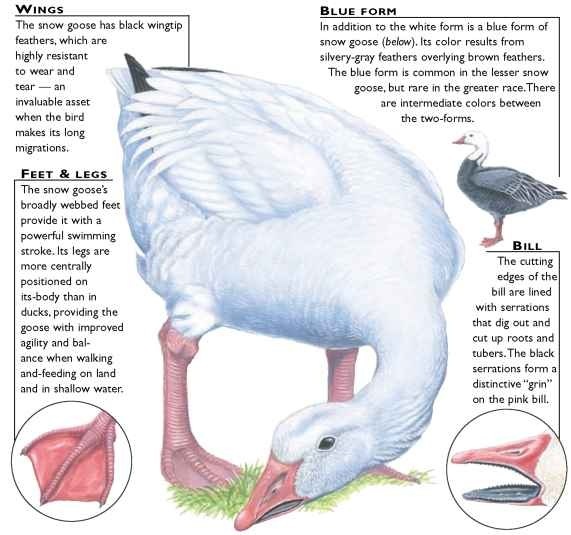
Creature comparisons
Like the snow goose, the red-breasted goose (Branta ruficollis) breeds on the Arctic tundra. Much smaller than the snow goose, it belongs to the group of geese known as “black geese” (genus Branta) rather than to the “gray geese” (genus Anser). It is distinguished by its beautiful plumage as well as rounded head and short neck and an extremely short bill
adapted for grazing-short grass and vegetation. Unlike the snow goose, ^ the red-breasted goose nests in small colonies of up to five pairs, often near peregrines, buzzards and large gulls.These birds drive Arctic foxes from the breeding colony, and the-red-breasted goose benefits from the association.
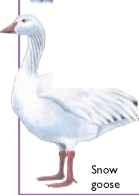

| VITAL | |
| STATISTICS | |
| Weight | 5.5-7 lbs. |
| Length | 26-33″ |
| Wingspan | 4.3-5.5′ |
| Sexual Maturity | 2 years, but does-not ‘usually breed until 3-4 years-old |
| Breeding Season | June-Sept. |
| Number 1 of Eggs | 2-10, but usually 4 or 5 |
| Incubation Period | 23-25 days |
| Fledging Period | !40-50 days |
| Breeding Interval | 1 year |
| Typical Diet | Wide variety of vegetation |
| Up to 17 | |
| Lifespan | years |
RELATED SPECIES
• The lesser snow goose, Anser caerulescens caerulescens, and the greater snow goose, A.-c.-atlanticus, share -the-genus Anser with 10 other species, including the-bar-headed goose, A.-indicus (below). Geese and swans are members of-the tribe Anserini.
